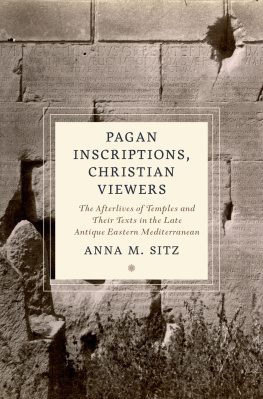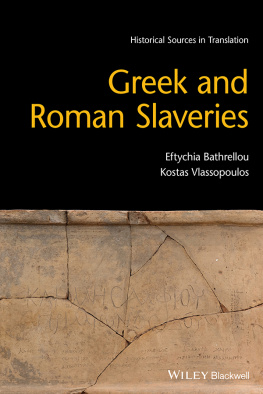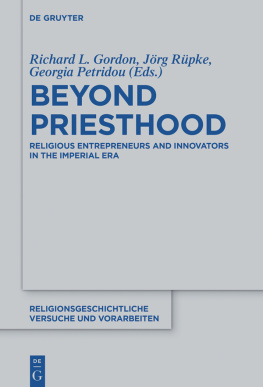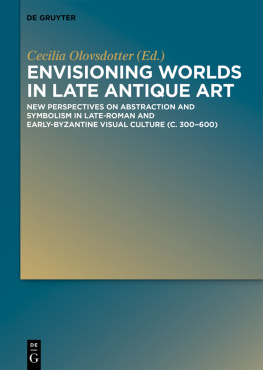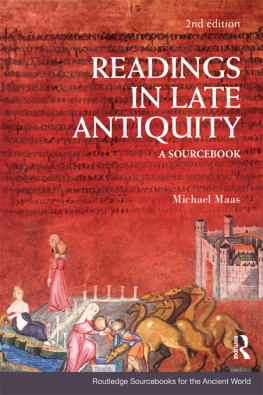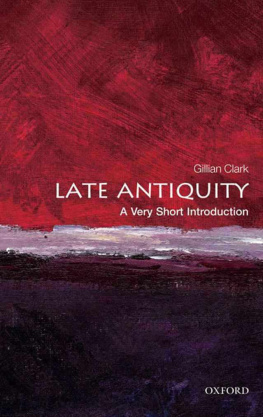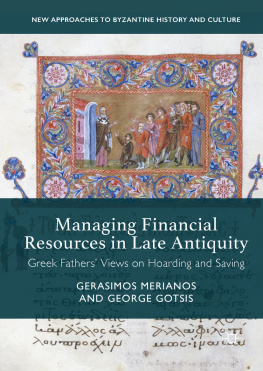
Amelia R. Brown is Senior Lecturer at the University of Queensland in Brisbane, Australia. She has published widely on ancient Greece in the late antique and early Byzantine periods.
Amelia R. Brown's study of the transformation of Corinth from a late Roman to an early Byzantine city between the third and the sixth century CE is a singular achievement. Using all available evidence written sources, inscriptions, archaeological materials with enormous expertise, Brown presents a detailed analysis of the entire city, its public places, religious sites, commercial and domestic spaces, waterways and other infrastructure, to demonstrate how, where and when exactly the Greek-Roman city became a Greek, Roman and Christian one. This book will become a model for all interested in the late Roman world and its aftermath. Through her detailed focus on Corinth, one of the most connected cities in the Mediterranean, Brown has offered a signal contribution to the age-old question of the fate of cities at the end of the Roman Empire: yes, there was decline and fall, but also practical continuity and, in the end, a transformed yet still recognizable Corinth.
Susanna K. Elm, Sidney H. Ehrman
Professor of European History,
University of California, Berkeley

Published in 2018 by
I.B.Tauris & Co. Ltd
London New York
www.ibtauris.com
Copyright 2018 Amelia R. Brown
The right of Amelia R. Brown to be identified as the author of this work has been asserted by the author in accordance with the Copyright, Designs and Patents Act 1988.
All rights reserved. Except for brief quotations in a review, this book, or any part thereof, may not be reproduced, stored in or introduced into a retrieval system, or transmitted, in any form or by any means, electronic, mechanical, photocopying, recording or otherwise, without the prior written permission of the publisher.
Every attempt has been made to gain permission for the use of the images in this book. Any omissions will be rectified in future editions.
References to websites were correct at the time of writing.
Library of Classical Studies 17
ISBN: 978 1 78453 823 1
eISBN: 978 1 78672 358 1
ePDF: 978 1 78673 358 0
A full CIP record for this book is available from the British Library
A full CIP record is available from the Library of Congress
Library of Congress Catalog Card Number: available
For Amy Summer and Mark Erasmus
CONTENTS
LIST OF FIGURES
Unless otherwise stated, all figures are reproduced courtesy of the American School of Classical Studies at Athens, Corinth Excavations, with thanks to James Herbst for the Corinth plans and credit to Ino Ioannidou and Lenio Bartzioti for the Corinth photographs.
The Roman province of Achaia (Byzantine Hellas).
The Corinthia and Northeastern Peloponnese.
The Corinthia from Acrocorinth to Lechaionin Late Antiquity.
The Forum Area of Ancient Corinth with the Panayia Field Excavations and the Great Bath.
Public buildings in the Forum Area of Ancient Corinth in Late Antiquity.
The Forum Area in Byzantine and Frankish Corinth.
The northern area of Ancient Corinth with the Circus and the Old Gymnasium. (Courtesy of Corinth Computer Project.)
Plans of four Christian basilica churches excavated at Corinth.
Plan of Isthmia. (Courtesy of The Ohio State University Excavations at Isthmia.)
Plan of Kenchreai. (From Scranton et al. 1978 (Kenchreai 1), Figure 4, Courtesy of The American Excavations at Kenchreai.)
Marble male head, probably of the fifth century, Corinth Museum inv. no. S-909.
Marble male head marked with a cross, probably of the fifth century, Corinth Museum inv. no. S-919. (Photo by Petros Dellatolas. Reproduced Courtesy of American School of Classical Studies at Athens, Corinth Excavations.)
Ancient Corinth and Acrocorinth, looking south from Lechaion in 1810, with columns of Temple of Apollo at center, panorama by Von Stackelberg. (Published in Williams 1829, vol. 1, pl. 9.)
Ancient Corinth and Acrocorinth, looking south from Lechaion in 2017. (Photo by author.)
Ancient Corinth, the Corinthian Gulf and Perachora, looking north from the slopes of Acrocorinth in 2017. (Photo by author.)
Ancient Corinth Forum Area, looking north from the South Stoa across the Forum at the Temple of Apollo, Northwest Shops and modern village church on the right (east). (Photo by author.)
Lechaion Road, looking north from the Propylaia, with Peirene Fountain, the Peribolos of Apollo and the modern village Plateia and church of Ancient Corinth on the right (east). (Photo by author.)
Marble statuette of Armed Aphrodite, Corinth Museum inv. no. S-2548.
Panayia Field Excavations, fourth century.
Panayia Field Excavations, sixth century.
Marble gladiator's tombstone, probably of the third century, Corinth Museum inv. no. I-2664.
Marble torso of a Nymph, with drill marks at waist, Corinth Museum inv. no. S-1024.
Corinth Excavations photograph from 1919 of Niko holding a newly excavated marble male head, probably of the fourth century, Corinth Museum inv. no. S-1199.
Marble female head, c.400, Corinth Museum inv. no. S-986.
Two female portrait bodies, both possibly representing Regilla, Corinth Museum inv. nos. S-55 and S-813.
Marble head of Dionysos, Corinth Museum inv. no. S-987.
Marble male portrait body, recarved from a female portrait body, Corinth Museum inv. no. S-2224.
Marble male portrait body wearing a chlamys, probably a late antique imperial official, Corinth Museum inv. no. S-314.
Corinth Excavations photograph from 1905 of a wall at the west end of the Northwest Shops which was built using marble bodies of late antique imperial officials and divine statuary (Imperial official S-819 and Artemis S-820 are visible).
Marble male portrait body wearing a chlamys, probably a late antique imperial official, recarved from a female body, perhaps Demeter, Corinth Museum inv. no. S-819.
Marble body of Artemis, Corinth Museum inv. no. S-820.
Marble male portrait body wearing a chlamys, probably a late antique imperial official, turned over from his reuse as a narthex door threshold in the Kraneion Basilica, Corinth Museum inv. no. S-3788. (Photo by author.)
Marble statue base for Parnasius, Corinth Museum inv. no. I-1115.
Marble temple pediment with a male portrait bust, probably a pagan priest, Corinth Museum inv. no. S-890.
Marble head of Tyche, personification of the Fortune of Corinth, Corinth Museum inv. no. S-1540.
ACKNOWLEDGEMENTS
I owe thanks first of all to my advisors from the University of California at Berkeley, where the Ph.D. dissertation which led to this book was completed in the Graduate Group in Ancient History and Mediterranean Archaeology in 2008. Susanna Elm nurtured my interest in Late Antiquity, and Ronald S. Stroud introduced me to epigraphy, Demeter, the American School of Classical Studies at Athens (ASCSA) and, most importantly, the ASCSA Corinth Excavations. Maria Mavroudi and Chris Hallett provided important guidance on the use of manuscripts and the study of Roman sculpture, respectively, and I also benefitted from courses taught by Andrew Stewart, Emily Mackil, Erich Gruen and the late Crawford Greenewalt.
I am grateful to the American School of Classical Studies at Athens for awarding me the John Williams White and Edward Capps Fellowships, during which I began research on my dissertation, and for ASCSA seminars taught by Carolyn Snively and John Pollini. I am grateful for guidance and academic support to the staff of the ASCSA Corinth Excavations, especially Director Guy D.R. Sanders, as well as Assistant Director Ioulia Tzonou-Herbst, Architect James Herbst, photographer Petros Dellatolas, Katherine Petrole and incoming Director Christopher Pfaff. I must single out for special thanks Assistant Director Emerita Nancy Bookidis, who gave me detailed feedback which I appreciate and have tried to follow. I appreciate conversations with Director Emeritus Charles K. Williams II and Numismatist Emeritus Orestes Zervos, and the remarkable photographs of Corinthian finds by the late Ino Ioannidou and Lenio Bartzioti. Thanks also to the three anonymous reviewers for I.B.Tauris and the editors; any errors that remain are mine.
Next page

